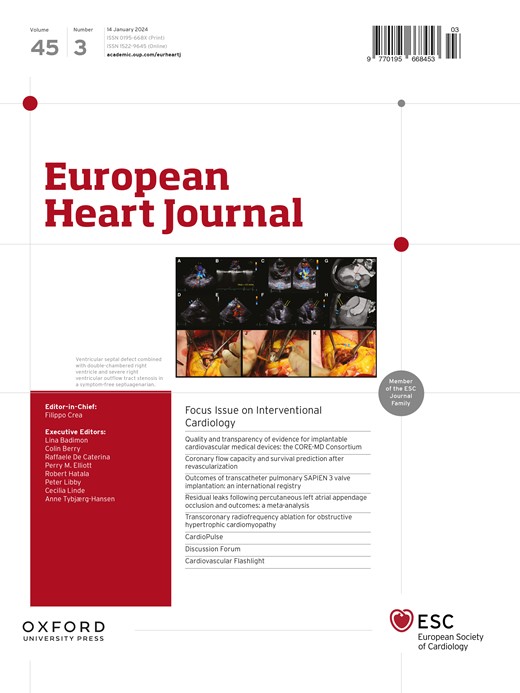EP4/ANXA2 axis in pulmonary arterial hypertension: therapeutic implications.
IF 35.6
1区 医学
Q1 CARDIAC & CARDIOVASCULAR SYSTEMS
引用次数: 0
Abstract
BACKGROUND AND AIMS Pulmonary arterial hypertension (PAH) is a progressive condition marked by the abnormal proliferation of pulmonary artery smooth muscle cells (PASMCs), leading to significant remodelling of the pulmonary arteries (PAs). The cyclooxygenase metabolite of arachidonic acid prostaglandin E2 and its receptor EP4 are crucial for maintaining vascular homeostasis. This study aimed to determine the role of EP4 in the pathogenesis of PAH and evaluate the potential of EP4 as a therapeutic target for PAH. METHODS Two well-established PAH models, the monocrotaline-induced rat model and hypoxia/Su5416-induced mouse model, were used in this study. Both pharmacological interventions (including the EP4 antagonist grapiprant and MF498 and the agonist Cay10598) and genetic strategies (including vascular smooth muscle cell [VSMC]-specific EP4 knockout mice and VSMC-specific human EP4 transgenic mice) were used to comprehensively investigate the role of EP4 in the pathogenesis of PAH. Multiple cellular and molecular biology approaches were employed to investigate the underlying mechanisms. RESULTS The results showed that the pharmacological blockade of the EP4 receptor and genetic deletion of the EP4 gene in VSMCs led to a significant improvement in PAH and PA remodelling. Conversely, pharmacological activation and VSMC-specific overexpression of EP4 exacerbate PAH progression. Further analysis identified annexin A2 (ANXA2) as a critical downstream mediator in EP4-induced PAH progression. Mechanistically, EP4 activation was found to enhance the translation of ANXA2 and phosphorylation of ANXA2 at Thr208 via the cAMP/PKA pathway, promoting PASMC proliferation and migration through increased nuclear translocation of β-catenin, a key signalling molecule in the canonical Wnt pathway. Importantly, pharmacological inhibition or genetic deletion of ANXA2 effectively protected PAH in rodents, suggesting its pathogenic role in PAH development. CONCLUSIONS This study reveals a crucial pathway involving EP4 and ANXA2 in PAH development and progression. Targeting EP4 and its downstream effector ANXA2 represents promising therapeutic strategies for PAH management.肺动脉高压中的EP4/ANXA2轴:治疗意义
肺动脉高压(PAH)是一种以肺动脉平滑肌细胞(PASMCs)异常增殖为特征的进行性疾病,导致肺动脉(PAs)的显著重构。花生四烯酸前列腺素E2的环加氧酶代谢物及其受体EP4对维持血管稳态至关重要。本研究旨在确定EP4在PAH发病机制中的作用,并评估EP4作为PAH治疗靶点的潜力。方法采用已建立的多环芳烃大鼠模型和缺氧/ su5416小鼠模型。通过药理干预(包括EP4拮抗剂grapiprant和MF498以及激动剂Cay10598)和遗传策略(包括血管平滑肌细胞[VSMC]特异性EP4敲除小鼠和VSMC特异性人EP4转基因小鼠),全面研究EP4在PAH发病机制中的作用。多种细胞和分子生物学方法被用来研究潜在的机制。结果结果表明,VSMCs中EP4受体的药物阻断和EP4基因的基因缺失导致PAH和PA重构的显著改善。相反,药理激活和vsmc特异性的EP4过表达会加剧PAH的进展。进一步分析发现膜联蛋白A2 (ANXA2)是ep4诱导的PAH进展的关键下游介质。从机制上看,EP4激活可通过cAMP/PKA通路增强ANXA2的翻译和Thr208位点ANXA2的磷酸化,通过增加β-catenin的核易位促进PASMC的增殖和迁移,β-catenin是典型Wnt通路中的关键信号分子。重要的是,药物抑制或基因缺失ANXA2可有效保护啮齿类动物的PAH,提示其在PAH发展中的致病作用。结论本研究揭示了EP4和ANXA2参与PAH发生发展的重要途径。靶向EP4及其下游效应物ANXA2是治疗PAH的有希望的治疗策略。
本文章由计算机程序翻译,如有差异,请以英文原文为准。
求助全文
约1分钟内获得全文
求助全文
来源期刊

European Heart Journal
医学-心血管系统
CiteScore
39.30
自引率
6.90%
发文量
3942
审稿时长
1 months
期刊介绍:
The European Heart Journal is a renowned international journal that focuses on cardiovascular medicine. It is published weekly and is the official journal of the European Society of Cardiology. This peer-reviewed journal is committed to publishing high-quality clinical and scientific material pertaining to all aspects of cardiovascular medicine. It covers a diverse range of topics including research findings, technical evaluations, and reviews. Moreover, the journal serves as a platform for the exchange of information and discussions on various aspects of cardiovascular medicine, including educational matters.
In addition to original papers on cardiovascular medicine and surgery, the European Heart Journal also presents reviews, clinical perspectives, ESC Guidelines, and editorial articles that highlight recent advancements in cardiology. Additionally, the journal actively encourages readers to share their thoughts and opinions through correspondence.
 求助内容:
求助内容: 应助结果提醒方式:
应助结果提醒方式:


